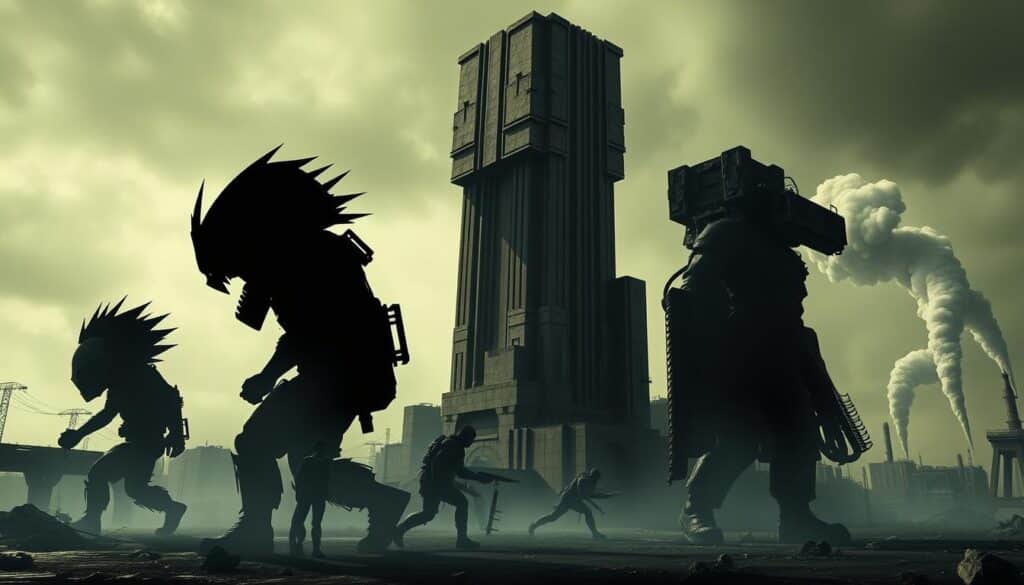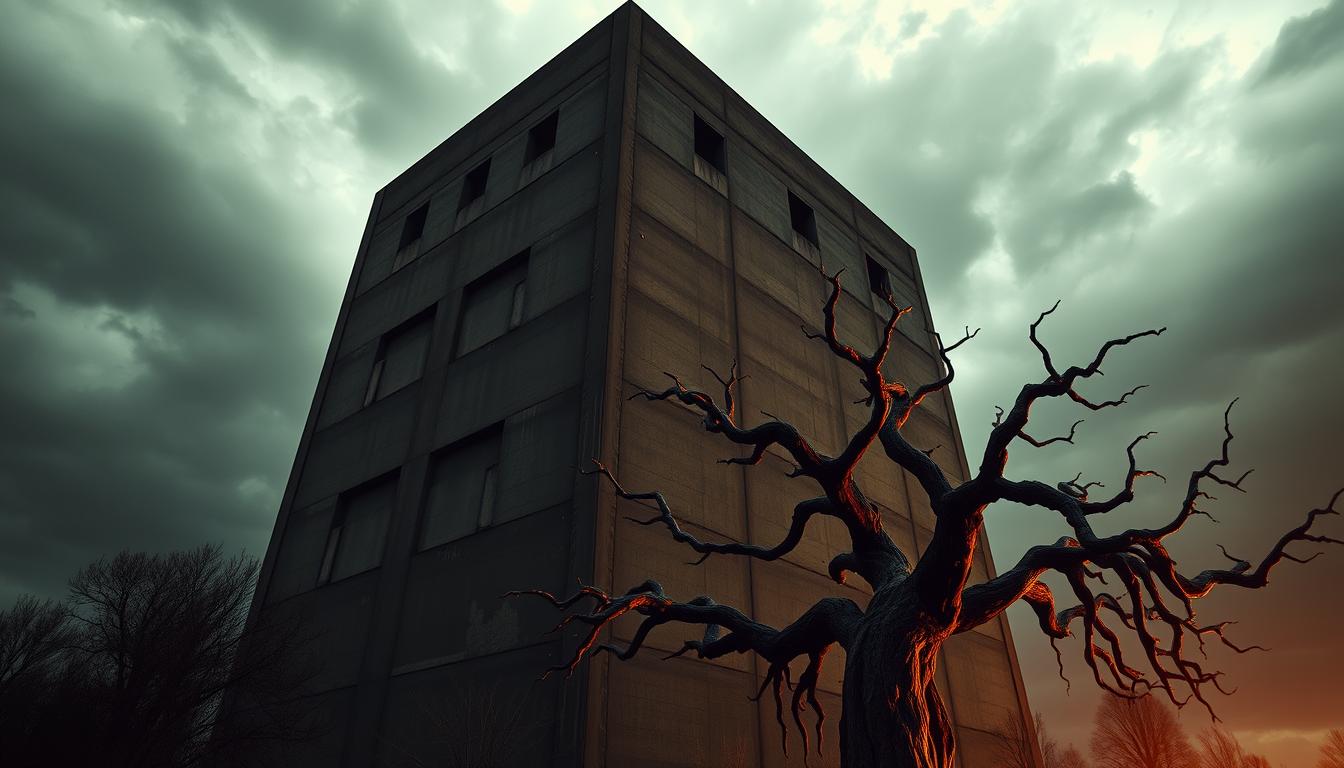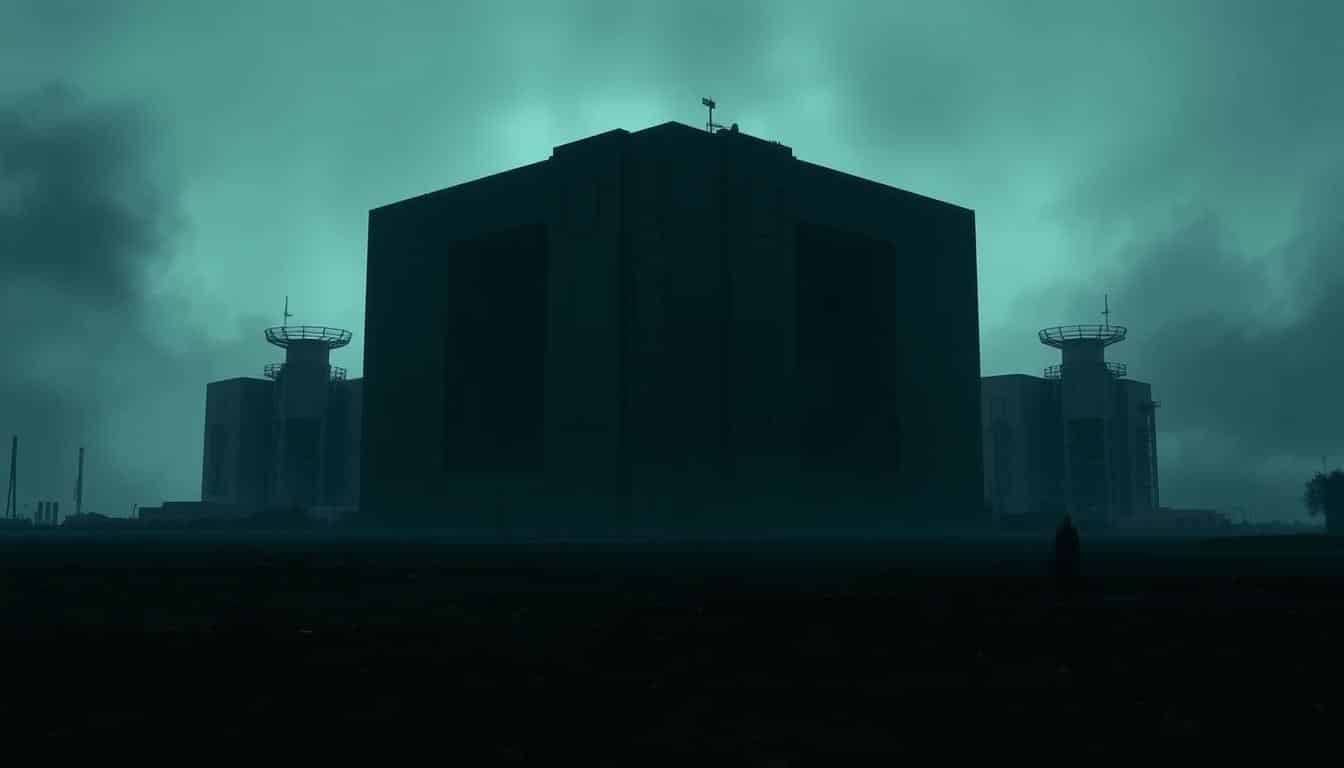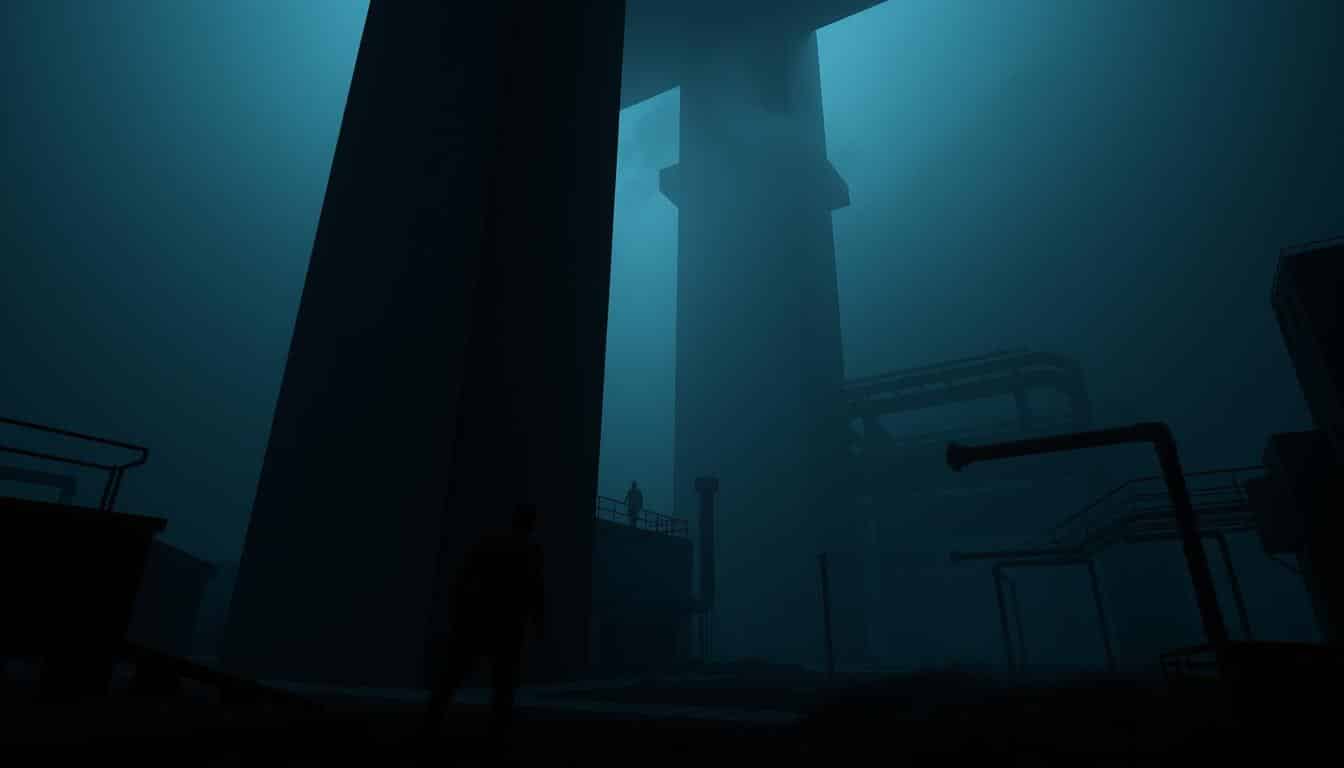The mix of brutalism and psychological terror in games offers players a unique, scary experience. This article talks about how the simple, raw look of brutalist architecture makes horror games even scarier. We will look at different games, both old and new, to see how brutalism makes the terror in games stronger.
The Evolution of Brutalism in Gaming
The look of video games has changed a lot, with brutalism becoming very important. This style is inspired by certain architectural ideas that started in the mid-1900s. It uses simple, powerful designs to show deep feelings and complex ideas. Game makers use this style to make worlds that pull you in, especially in scary stories.
Brutalism started as a way to make buildings simple and focus on their materials and use. In gaming, developers have been using these ideas more and more. Games like “Dark Souls” and “Control” show this style well. They use rough textures and big, scary buildings to make players feel a real sense of fear.
Brutalism in games has hit some key points over time. It started with the older 8-bit games that were simple and not too detailed. But as games got better tech, newer ones began to show off brutalism’s raw beauty. They created stunning worlds that match the complex stories they tell.

Using brutalism, game designers keep pushing us to explore deep topics and feelings. Adding this style to games shows how game visuals have grown. It also makes games more engaging and deep.
What is Psychological Terror in Video Games?
Psychological terror in video games is about making you feel anxious, scared, and uneasy. It’s different from regular horror games. Instead of just scaring you with sudden shocks or creepy images, it gets inside your head. This kind of terror slowly builds tension, rather than startling you with scary visuals right away.
Here’s what psychological horror games use to scare you:
- Unreliable Narratives: These stories make you unsure about what’s real or not. This confusion can make the game even scarier.
- Environmental Storytelling: The game’s setting tells part of the story. Small details in the world around you can make you feel more scared.
- Player Isolation: Being alone in the game makes you feel more vulnerable. This feeling makes the game’s world more real and scary.
These techniques combine to create a deep, scary experience. By knowing how psychological terror works, players can understand how these games play with their feelings. This creates an unforgettable, spooky gaming adventure.
The Impact of Visual Aesthetics on Player Experience
Visual looks in games are very important for player immersion and their emotional link to the game. In horror games, the use of brutalist design can make players feel more isolated and scared. This design style uses plain, heavy-looking structures to shape environments. It triggers strong feelings in players, showing how game looks can influence player feelings.
Defining Brutalist Architecture and its Influence
Brutalist architecture is known for its simple concrete forms and sharp edges. It can make players feel alone and exposed. By adding this style into games, an eerie vibe is created that fits well with horror themes. It makes players feel tiny and weak, which raises the scare factor while they explore these game worlds.
Atmospheric Dread: The Role of Environment in Horror
Atmospheric elements like lighting, sound, and storytelling can increase tension in horror games. They work with the brutalist style to make emotional responses stronger. The sound of steps echoing and the mix of light and shadows can make players feel watched or stuck. This draws them deeper into the game’s scary world.
The Marriage of Brutalism and Psychological Terror in Gaming
Brutalism and horror in gaming create a unique mix that boosts feelings during play. The harsh, raw look of brutalist architecture makes a setting that grabs and scares players. By adding psychological horror elements, game makers create places that make players feel alone and afraid. This helps players connect more with the story.
Some games really shine by combining these two aspects. Games like “Layers of Fear” show how simple, brutal visuals boost scary stories. The darkness of the settings matches the inner struggles of characters, making the game more real. Also, the focus on these spooky settings is key to making a game truly scary.
As players move through these carefully made worlds, they face their fears. The mix of brutalist style and horror creates memorable tension. This careful pairing highlights how games can tell stories through visuals. It also makes players think more about the feelings games bring out.
Upcoming Titles Embracing This Unique Blend
The gaming world is always changing. Now, it’s merging horror games with a style called brutalism alongside psychological scares. A game called Cronos: The New Dawn is creating a lot of excitement. It promises a scary adventure in a future world, where the setting is very important to the fear it creates.
Cronos: The New Dawn – A Case Study
Cronos: The New Dawn’s previews show a mix of Eastern European brutalism and futuristic designs. In this game, players explore a place with stark buildings and creepy vibes. This mix makes the game scarier, inviting players to dive deep into its spooky story and complex play.
Comparison with Existing Titles
Looking at other games, Dead Space and Layers of Fear stand out for their horror elements. Dead Space scares with alien-infested areas, while Layers of Fear uses psychological horror with artsy scenes. Both have elements like those in Cronos: The New Dawn. They show how different ways of using brutalism and mind scares can create deep fear.
- Cronos: The New Dawn focuses on environmental storytelling through stark aesthetics.
- Dead Space emphasizes horror through combat mechanics intertwined with the setting.
- Layers of Fear portrays fear through narrative and artistic styles.
This mix in the upcoming horror games will give players varied and challenging experiences. It will make them rethink fear and how they get into games.
The Role of Storyline in Psychological Horror
A compelling storyline is key in psychological horror games, making them truly immersive. These games delve into deep themes like trauma and existential fears. Players face choices that make them question what’s real and what’s not, adding depth to the game’s stories.
Character growth is vital in these games. Well-developed characters make players feel more connected, increasing fear and tension. As players move through the game, their choices change the story. This showcases the power of psychological fear in gaming.
Games like Silent Hill and Alan Wake are great examples. They mix deep stories with rich characters against eerie settings. This combination makes the horror in these games feel more real and intense.
Gameplay Mechanics that Enhance Terror
Psychological horror games get much of their scary atmosphere from clever game mechanics. These tools make the game’s world feel real and frightening. Game makers use many tricks to pull players in. Making every choice important ramps up the game’s intensity. A common tactic is to give players only a few items to use, adding pressure to make wise decisions. This scarcity ups the anxiety, and makes the game more absorbing and edgy.
How you interact with the game world also ramps up the fear. The game’s environment reacts to what you do, making each action feel significant. Sounds, like footsteps or eerie whispers, can make you more nervous. These elements keep you on your toes, constantly worried about what might be lurking around the corner.
Enemies that act in surprising ways also increase the scare factor. They might follow you secretly or change their behavior based on your actions. This unpredictability means you have to constantly change how you play. Every encounter with these foes is thrilling and filled with tension.
Understanding how these gaming tricks work deepens the fear felt during play. By facing these challenges, players not just hear a scary story; they live it through the game’s design. The mix of fear and clever strategies makes the horror stick with you, long after you’ve stopped playing.
Why Players are Drawn to This Combination
Horror games are fascinating because they mix psychology and fear in a safe way. They let players experience danger without real risk, giving them a thrill. Facing these fears in a game can be very exciting and offers a great escape.
Playing horror games lets people face their fears indirectly. It feels like they have control over their scary situations in the game. Many find relief and a way to deal with tough emotions safely through these games.
Gaming with others also makes horror games more appealing. Players share their scary experiences and stories with each other. This sharing creates a sense of community and belonging, making the scary fun more enjoyable. Talking about game fears and victories helps players connect on deeper levels.
Critical Reception and Future Prospects
Horror games with scary stories and visuals get mixed reviews. Some praise them for their deep psychological fear. They highlight the games’ power to scare and unsettle players. People like the new ways these games make the story feel real and emotional. This shows a move towards better storytelling in games.
Looking at how people react to horror games shows a trend. More people are okay with unusual stories and graphics. The future looks promising for scary games, thanks to tech improvements. Better graphics, virtual reality, and sound can make the game experience much scarier. This could lead to more in-depth exploration of fear.
Game makers are getting better at including both harsh designs and deep psychology. Listening to what players say is key for the future of these games. This way, games can truly touch on our fears and feelings. The outlook for scary games is exciting. It’s driven by new ideas and what players want. This means we can expect even more chilling and meaningful game experiences.
Conclusion
In the gaming world, the mix of brutalism and psychological terror creates a rich story and hooks players in. The strong visuals combined with an eerie atmosphere challenge players. This pulls them into the story even more. This chat about brutalism and psychological terror shows how the horror genre is changing. It opens up new ways to design games and play them.
Games are getting more exciting as creators keep exploring these ideas. They’re pushing limits and making horror games more moving. Gamers like games that truly scare them. This means creators have to keep coming up with new ideas that scare and interest players. This mix of scary visuals and good stories doesn’t just thrill players. It makes them think and feel deeply.
When both gamers and critics dig into brutalism and psychological terror, they see the real skill in horror games. Looking ahead, we see the importance of this unique mix in gaming. It’s key to understand the art in these games. They can change the way stories are told in games.



